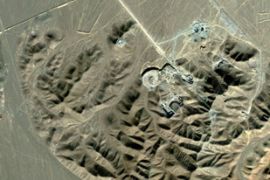Iran dismisses nuclear concerns
UN agency report on enrichment site proves nuclear programme is peaceful, envoy says.

The report, which is the first official document since the inspection, said Iran’s delay in revealing the existence of the site at Qom raised questions about whether other such facilities exist.
“The agency has indicated [to Iran] that its declaration of the new facility reduces the level of confidence in the absence of other nuclear facilities under construction and gives rise to questions about whether there were any other nuclear facilities not declared to the agency,” it said.
‘No justification’
But Soltanieh dismissed the agency’s concerns.
“We reject this 100 per cent. This kind of judgment is absolutely wrong, unfair, political and beyond the [IAEA’s] mandate. There is no justification for it,” he told the Reuters news agency.
While Iran claims to have started working on the country’s second enrichment plant began in 2007, the IAEA says it has evidence that the Qom project began in 2002, was paused in 2004 and resumed in 2006.
|
“This is a contingency site, complementary to Natanz, in order that our enrichment process will never, ever be suspended” Ali Asghar Soltanieh, |
Western experts say the new plant hidden in a mountain could go live as early as 2011 and could produce enough enriched uranium to arm a nuclear warhead within a year.
Speaking to Al Jazeera, Paul Brannan, a senior research analyst with the Washington-based Institute for Science and International Security, said: “The satellite imagery that the IAEA is looking at indicates that the tunnel entrances associated with the facility were built back in 2002.
“The satellite imagery analysis that we have done tends to support the notion that the tunnel entrances back in 2002 may not yet have been associated with the enrichment plan.
“The atomic energy organisation of Iran may have made the decision to build the enrichment plant and then may have sited it at the Qom facility.
“But nevertheless it looks like the satellite imagery shows that the construction would have begun before June 2007, which would put it at the first half of 2007 at the earliest, so that doesn’t quite jibe with what Iran was telling the IAEA.”
Soltanieh said the site, which was only disclosed in September after its existence had apparently been discovered by foreign intelligence agencies, had only been built in case its main Natanz plant was bombed.
“This is a contingency site, complementary to Natanz, in order that our enrichment process will never, ever be suspended. Its purpose is just to have a more protected, secure site,” he said.
‘Strike-proof’ plant
The IAEA inspectors also found that Iran had recently reduced the number of centrifuges enriching uranium at its main Natanz site by 650 to 3,936, while slightly raising the total number of machines installed to 8,692.
Alireza Ronaghi, Al Jazeera’s correspondent in Tehran, said: “Iran plans to prove that its nuclear programme is unstoppable.
“That’s why they have built this strike-proof – that’s what Iran calls it – nuclear plant under the mountains near Qom to prove that Iran will never stop its nuclear programme.
“And that’s a concern big enough for some of the world powers who are dealing with Iran now.
Barack Obama, the US president, said during a visit to China on Tuesday that there would be consequences if Iran would not demonstrate that its nuclear programme was “peaceful and transparent” and called for an answer to a deal put forward by world powers.
The US, Russia, China, Britain, France and Germany are seeking to persuade Iran to accept an uranium enrichment freeze under a plan of exporting Iran’s uranium abroad in exchange for fuel.